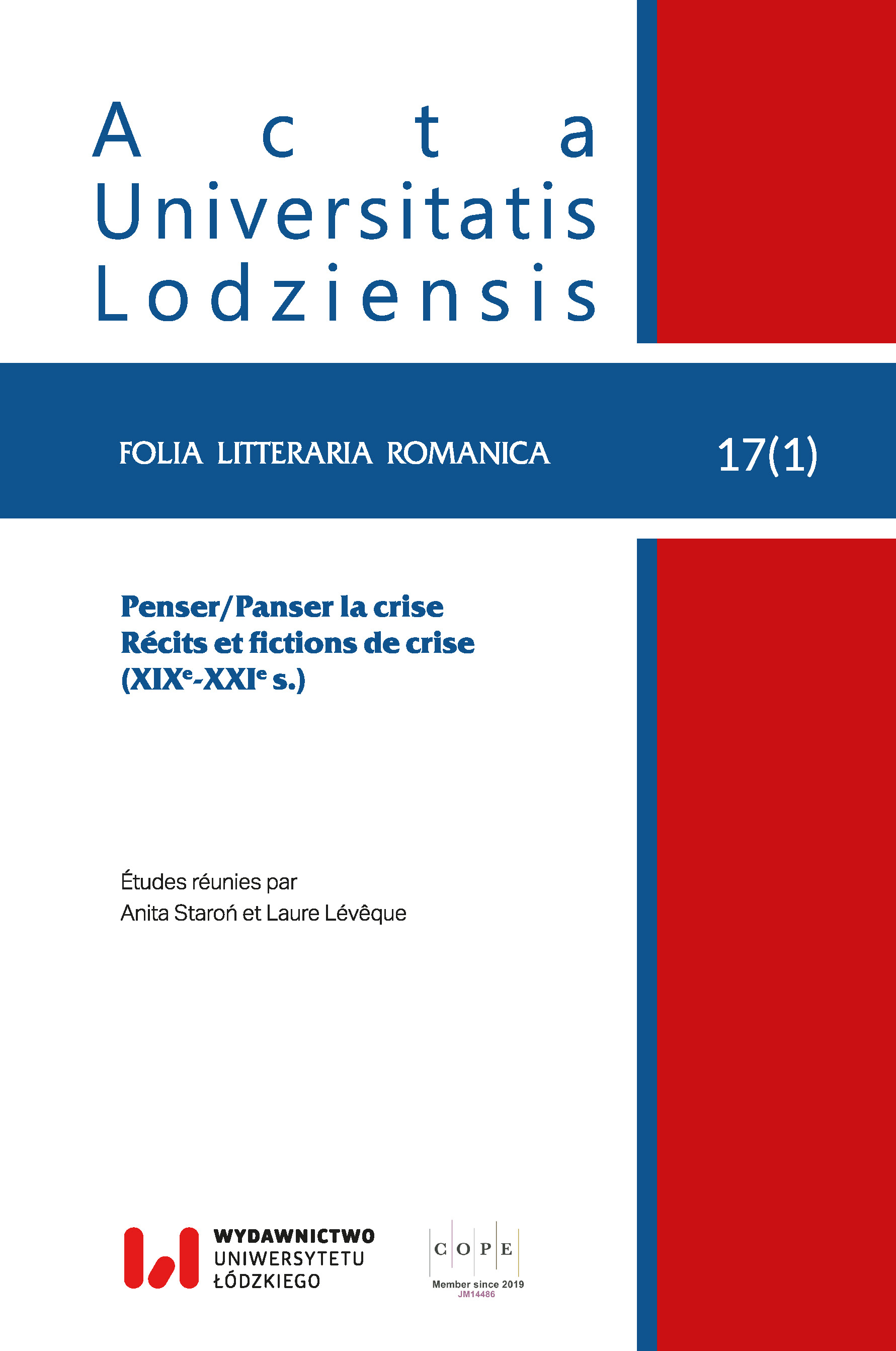Extérioriser l’intime ou la crise permanente du théâtre. "La Maison d’os" de Roland Dubillard : « monodrame polyphonique » ?
DOI:
https://doi.org/10.18778/1505-9065.17.1.12Słowa kluczowe:
Roland Dubillard, « drame absolu », crise du théâtre, « dramaturgie rhapsodique », « monodrame polyphonique »Abstrakt
La Maison d’os de Rolland Dubillard se situe explicitement dans le sillage de la « dramaturgie rhapsodique » qui remet en cause les contraintes de la forme canonique que Szondi a définie comme le « drame absolu ». N’étant pas fondée sur un grand conflit, la construction de l’œuvre ne respecte pas la dynamique de l’action (au demeurant, inexistante), tout en se concentrant sur la confrontation d’un protagoniste avec lui-même. Ainsi, l’intersubjectif, sur lequel est bâtie une pièce traditionnelle, cède la place à l’intrasubjectif qui se manifeste, en l’occurrence, au travers d’un monodrame polyphonique. De fait, en étudiant le texte de Dubillard, on constate que l’auteur renonce à l’ancien paradigme pour mieux explorer l’intériorité du personnage principal. Celui-ci mène une vie de solitaire, entouré par ses nombreux valets qui semblent les pâles reflets de son âme déchirée. S’affranchissant du monologue, l’écrivain conçoit de cette manière un monodrame à plusieurs voix. Ce procédé ne signifie pourtant pas la crise du genre, il constitue une des solutions permettant son évolution.
Pobrania
Bibliografia
Dubillard, Roland, La Maison d’os, Paris, Gallimard, 1966
Google Scholar
Aron, Paul, « Mimodrame et monodrame : deux formes méconnues de la crise du théâtre », Études théâtrales, 1999, no 15-16, p. 178-191
Google Scholar
Artaud, Antonin, Le Théâtre et son double, Paris, Gallimard, 1938, rééd. 1964, 1985
Google Scholar
Bernard-Gresh, Sylviane, « La Maison d’os », Télérama, 1 avril 2013, https://www.theatredurondpoint.fr/spectacle/la-maison-dos/ consulté le 3.05.2021
Google Scholar
Birgé, Jean-Jacques, « La Maison d’os, c’est Dubillard ! », Mediapart, 2 avril 2013, https://blogs.mediapart.fr/jean-jacques-birge/blog/010413/la-maison-dos-cest-dubillard consulté le 3.05.2021
Google Scholar
Blanchot, Maurice, L’Espace littéraire, Paris, Gallimard, 1955
Google Scholar
Blanchot, Maurice, L’Écriture du désastre, Paris, Gallimard, 1980
Google Scholar
Corvin, Michel, « Le dedans et le dehors ou l’être-là dans le théâtre de Roland Dubillard », Europe, 2018, no 1065-1066, p. 11-28
Google Scholar
Corvin, Michel, « Roland Dubillard », in Dictionnaire encyclopédique du théâtre, éd. M. Corvin, Paris, Larousse, 2001, p. 533-534
Google Scholar
Danan, Joseph, « Monodrame (polyphonique) », in Lexique du drame moderne et contemporain, éd. J.-P. Sarrazac, Circé, 2010, p. 122-124
Google Scholar
Dejean, Jean-Luc, Le théâtre français d’aujourd’hui, Paris, Fernand Nathan, 1971
Google Scholar
Garcin-Marrou, Flore, « Le drame émancipé », Études théâtrales, 2013, no 56-57, p. 171-181, https://doi.org/10.3917/etth.056.0171
Google Scholar
DOI: https://doi.org/10.3917/etth.056.0171
Gautier, Jean-Jacques, « La Maison d’os, de Roland Dubillard », Le Figaro, 23 novembre 1962 https://doi.org/10.1051/jphysrad:01962002302010500
Google Scholar
DOI: https://doi.org/10.1051/jphysrad:01962002302010500
Green, André, Un œil en trop : le complexe d’Œdipe dans la tragédie, Paris, Éditions de Minuit, 1969
Google Scholar
Ionesco, Eugène, Notes et contre-notes, Paris, Gallimard, 1966
Google Scholar
Járay-Benn, Csilla, « Les objets-personnages et les personnages-objets de Rolland Dubillard. La mobilité des objets dans les œuvres théâtrales », Revue d’esthétique 34, 1998, p. 267-284
Google Scholar
Klieger Stillman, Linda, « Doubling of Sign and Image in Roland Dubillard’s La Maison d’ os », SubStance, 1979, no 1, issue 22, p. 85-95, https://doi.org/10.2307/3684145
Google Scholar
DOI: https://doi.org/10.2307/3684145
Poudevigne, Sonia, La Théâtralité ou le théâtre dans la vie chez Nicolas Evreinov, Éditions universitaires européennes, 2019
Google Scholar
Ryngaert, Jean-Pierre, Sermon, Julie, Le Personnage théâtral contemporain : décomposition, recomposition, Montreuil, Éditions Théâtrales, 2006
Google Scholar
Sarraute, Claude, « La Maison d’os : une pièce sur l’abandon de la mort ? », France-Observateur, 29 novembre 1962, in « Roland Dubillard », Revue d’esthétique, 1998, 34, p. 319-320
Google Scholar
Sarrazac, Jean-Pierre, L’Avenir du drame, Lausanne, Éditions de l’Aire, 1981
Google Scholar
Sarrazac, Jean-Pierre, Poétique du drame moderne. De Henrik Ibsen à Bernard-Marie Koltès, Paris, Éditions du Seuil, 2012
Google Scholar
Sarrazac, Jean-Pierre, Théâtres intimes, Paris, Actes Sud, 1989
Google Scholar
Serreau, Geneviève, Histoire du « nouveau théâtre », Paris, Gallimard, 1966
Google Scholar
Szondi, Peter, Théorie du drame moderne, [trad. P. Pavis, Lausanne, L’Âge d’Homme, 1983] Belval, Circé, coll. « Penser le théâtre », 2006.
Google Scholar
Wilkinson, Robin, « Roland Dubillard, auteur de théâtre », Revue d’esthétique, 1998, 34, p. 199-219
Google Scholar
Wilkinson, Robin, Le Théâtre de Roland Dubillard, essai d’analyse sémiologique, Berne, P. Lang, 1989
Google Scholar
Opublikowane
Jak cytować
Numer
Dział
Licencja

Utwór dostępny jest na licencji Creative Commons Uznanie autorstwa – Użycie niekomercyjne – Bez utworów zależnych 4.0 Międzynarodowe.













